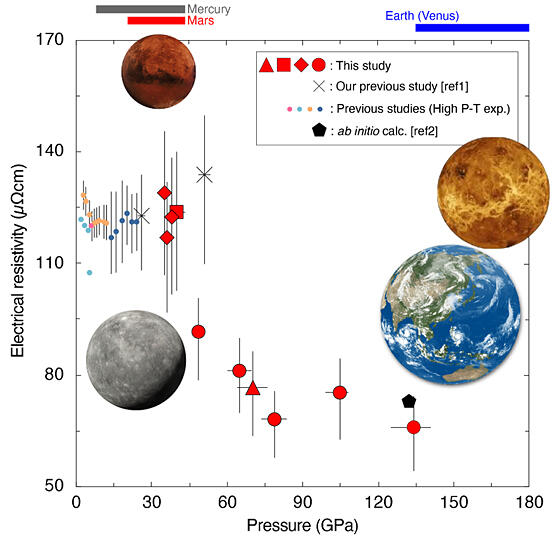A research team led by Associate Professor Kenji Ohta and his colleagues of the Department of Earth and Planetary Sciences, School of Science at the Tokyo Institute of Technology (Tokyo Tech), and Senior Researcher Saori Kawaguchi of the Japan Synchrotron Radiation Research Institute (JASRI) has successfully determined the electrical resistivity of pure liquid iron, which is the main component constituting the cores of terrestrial planets, under extreme conditions (140 GPa and 6000 ℃) that closely resemble those prevalent in the Earth's core environment. The related paper has been published in Physical Review Letters.

Provided by Tokyo Institute of Technology
The terrestrial planets of the solar system (Mercury, Venus, Earth, and Mars) have cores primarily composed of liquid iron. These planets generate their intrinsic magnetic fields through convection in the liquid cores. As these planets cool internally, inner cores, mainly composed of solid iron, form and continue to grow.
Identifying the presence or absence of magnetic fields generated by terrestrial planets and the timings of their inner core formations represents an important challenge in Earth and planetary science. The key to understanding these phenomena lies in the electrical and thermal conductivities of pure liquid iron. However, obtaining precise measurements of the electrical resistivity of iron in a molten state under high pressures equivalent to those found in planetary cores has proven to be extremely difficult. Even under conditions similar to those prevalent at the centers of smaller planets such as Mercury or Mars (approximately 40 GPa), obtaining similar measurements has proven to be challenging owing to significant deformations of iron samples during melting and their reactions with surrounding materials.
The research team has been working toward understanding the physical properties of the Earth's core using a diamond anvil cell apparatus that allows the retention of iron samples at high temperatures and pressures.
In this study, they successfully devised and implemented the sapphire capsule method, which involves covering the entire iron sample with a hard sapphire single crystal. This method effectively suppresses the deformation and chemical reactions of the iron sample during melting. Furthermore, the research team developed an instantaneous resistance detection method to assess the electrical resistivity, temperature, and crystal structure of the iron sample instantaneously heated using a laser on the order of milliseconds.
The instantaneous resistance detection method is a technique that can be realized using the state-of-the-art high-speed X-ray detector recently introduced at SPring-8, a large synchrotron radiation facility in Japan. This method enables the measurement of electrical resistivity before sample deformation occurs during melting. The electrical resistivity of liquid iron within a pressure range of 35-140 GPa, which covers the pressure conditions of terrestrial planet cores in the solar system, has was determined.
According to this study, the obtained electrical resistivity of pure liquid iron subjected to Earth's core conditions is consistent with the resistivity values reported based on theoretical calculations. This value aligns with the previous estimate of approximately 700 million years for the onset of Earth's inner core formation. The electrical resistivity of liquid iron has also been observed to rapidly decrease from approximately 50 GPa at its melting point.
This indicates the presence of a nearly two-fold difference in the conductivities of liquid iron under the core pressure conditions of Mercury/Mars and Venus/Earth, which, in turn, suggests a similar disparity in the cooling rates of planets. The size (internal pressure) difference among terrestrial planets has been identified as a factor governing the conductivities of their cores. This discovery is expected to advance understanding of the diversity among magnetic fields and the thermal evolution of terrestrial planets.
Journal Information
Publication: Physical Review Letters
Title: Measuring the Electrical Resistivity of Liquid Iron to 1.4 Mbar
DOI: 10.1103/PhysRevLett.130.266301
This article has been translated by JST with permission from The Science News Ltd. (https://sci-news.co.jp/). Unauthorized reproduction of the article and photographs is prohibited.




